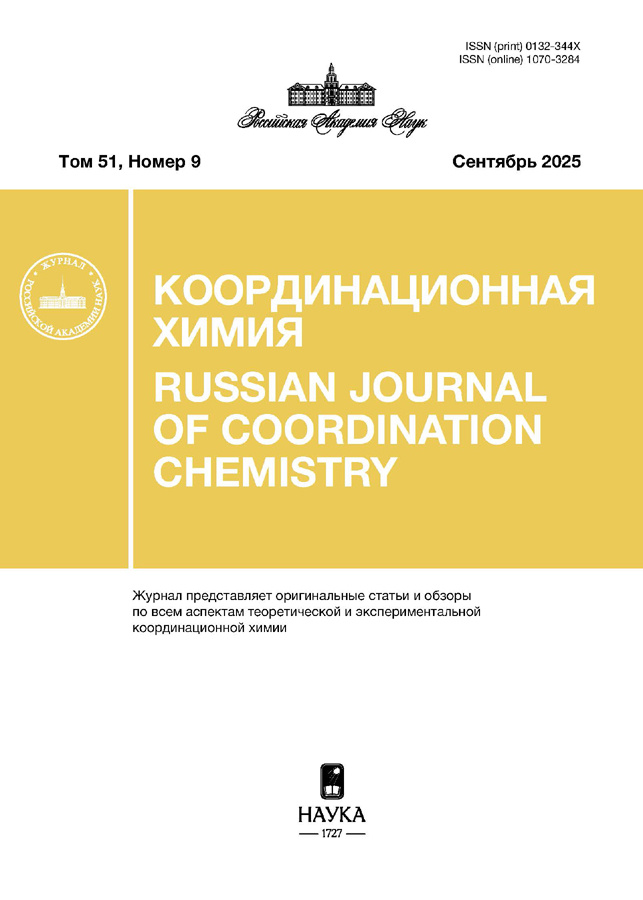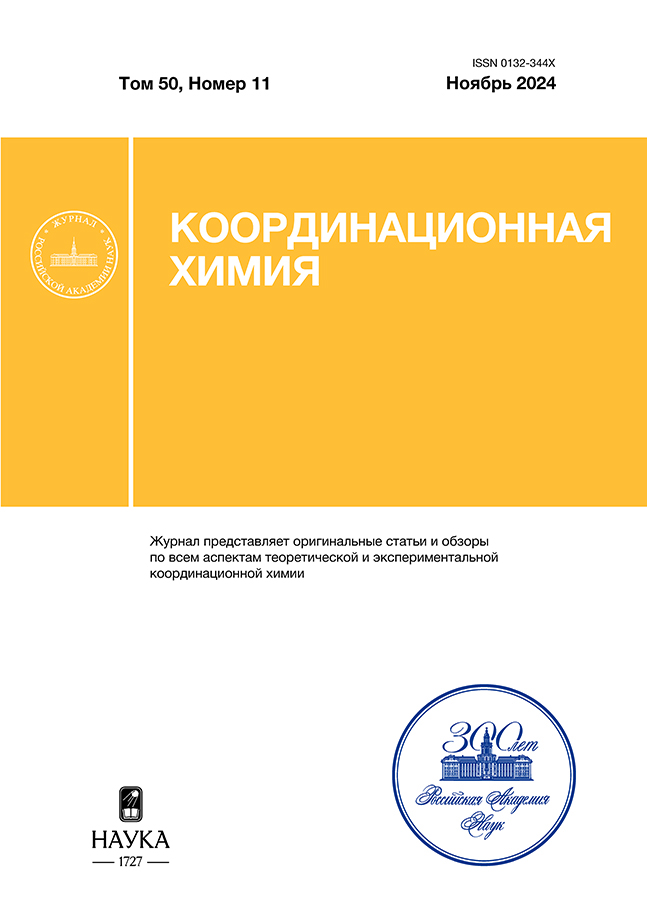Координационные соединения 3d-металлов с 2,4-диметилпиразоло[1,5-а]бензимидазолом: магнитные и биологические свойства
- Авторы: Шакирова О.Г.1,2, Кузьменко Т.А.3, Куратьева Н.В.1, Клюшова Л.С.4, Лавров А.Н.1, Лавренова Л.Г.1
-
Учреждения:
- Институт неорганической химии им. А. В. Николаева СО РАН
- Комсомольский-на-Амуре государственный университет
- Институт физической и органической химии Южного федерального университета
- Институт молекулярной биологии и биофизики, Федеральный исследовательский центр фундаментальной и трансляционной медицины
- Выпуск: Том 50, № 11 (2024)
- Страницы: 773-786
- Раздел: Статьи
- URL: https://rjonco.com/0132-344X/article/view/667649
- DOI: https://doi.org/10.31857/S0132344X24110033
- EDN: https://elibrary.ru/LMVCGZ
- ID: 667649
Цитировать
Полный текст
Аннотация
Синтезированы и исследованы новые координационные соединения меди(I), меди (II), кобальта(II) и никеля(II) c 2,4-диметилпиразоло[1,5-а]бензимидазолом (L) состава [CuLCl] (I), [CuLBr] (II), [CuL2Cl2] (III), [CuL2(NO3)2] · H2O (IV), [CoL2Cl2] · 0,5H2O (V), [CoL2(NO3)2] · 0,5H2O (VI), [NiL2(NO3)2] · 0,5H2O (VII). Соединения изучены методами ИК-спектроскопии, РФА и РСА (CCDC № 2321779 ([CuL2Cl2]), 2321780 ([CoL2(NO3)2])). Полученные данные позволяют сделать вывод, что координационный полиэдр в исследуемых комплексах с 2,4-диметилпиразоло[1,5-а]бензимидазолом формируется за счет атомов азота монодентатно координированного лиганда и координированных анионов. На клеточной линии гепатоцеллюлярной карциномы HepG2 изучены цитотоксические и цитостатические свойства L и комплексов I–III.
Полный текст
Об авторах
О. Г. Шакирова
Институт неорганической химии им. А. В. Николаева СО РАН; Комсомольский-на-Амуре государственный университет
Автор, ответственный за переписку.
Email: Shakirova_Olga@mail.ru
Россия, Новосибирск; Комсомольск-на-Амуре
Т. А. Кузьменко
Институт физической и органической химии Южного федерального университета
Email: Shakirova_Olga@mail.ru
Россия, Ростов-на-Дону
Н. В. Куратьева
Институт неорганической химии им. А. В. Николаева СО РАН
Email: ludm@niic.nsc.ru
Россия, Новосибирск
Л. С. Клюшова
Институт молекулярной биологии и биофизики, Федеральный исследовательский центр фундаментальной и трансляционной медицины
Email: Shakirova_Olga@mail.ru
Россия, Новосибирск
А. Н. Лавров
Институт неорганической химии им. А. В. Николаева СО РАН
Email: ludm@niic.nsc.ru
Россия, Новосибирск
Л. Г. Лавренова
Институт неорганической химии им. А. В. Николаева СО РАН
Email: ludm@niic.nsc.ru
Россия, Новосибирск
Список литературы
- Селиванова Г.А., Третьяков Е.В. // Изв. АН. Сер. хим. 2020. № 5. С. 838. https://doi.org/10.1007/s11172-020-2842-3 (Selivanova G.A., Tretyakov E.V. // Russ. Chem. Bull. 2020. V. 69. № 5. P. 838). https://doi.org/10.1007/s11172-020-2842-3
- Прошин А.Н., Трофимова Т.П., Зефирова О.Н. и др. // Изв. АН. Сер. хим. 2021. № 3. С. 510). https://doi.org/10.1007/s11172-021-3116-4 (Proshin A. N., Trofimova T.P., Zefirova O.N. et al. // Russ. Chem. Bull. 2021. V. 70. № 3. P. 51). https://doi.org/10.1007/s11172-021-3116-4]
- Кокорекин В.А., Ходонов В.М., Неверов С.В. и др. // Изв. АН. Сер. хим. 2021. № 3. С. 600). https://doi.org/10.1007/s11172-021-3131-5 (Kokorekin V.A., Khodonov V.M., S.V. Neverov S.V. et al. // Russ. Chem. Bull. 2021. V. 70. № 3. С. 600). https://doi.org/10.1007/s11172-021-3131-5
- Sadaf H., Fettouhi M., Fazal A. et al. // Polyhedron. 2019. V. 70. Р. 537. https://doi.org/10.1016/j.poly.2019.06.025
- Muñoz-Patiño N., Sanchez-Eguia B.N., Araiza-Olivera D. et al. // J. Inorg. Biochem. 2020. V. 211. Р. 111198). https://doi.org/10.1016/j.jinorgbio.2020.111198
- ChkirateK., KarrouchiK., DedeN. et al. // New J. Chem. 2020. V. 44. Р. 2210. https://doi.org/10.1039/C9NJ05913J
- Masaryk L., Tesarova B., Choquesillo-Lazarte D. et al. // J. Inorg. Biochem. 2021. V. 217. Р. 111395). https://doi.org/10.1016/j.jinorgbio.2021.111395
- Aragón-Muriel A., Liscano Y., Upegui Y. et al. // Antibiotics. 2021. V. 1. № 6. Р. 728). https://doi.org/10.3390/antibiotics10060728
- Alterhoni E., Tavman A., Hacioglu M. et al. // J. Mol. Struct. 2021. V. 1229. Р. 129498). https://doi.org/10.1016/j.molstruc.2020.129498
- Raducka A., Świątkowski M., Korona-Głowniak I. et al. // Int. J. Mol. Sci. 2022. V. 23. № 12. Р. 6595). https://doi.org/10.3390/ijms23126595
- Üstün E., Şahin N., Özdemir İ. et al. // Arch. Pharm. 2023. Art. e2300302). https://doi.org/10.1002/ardp.202300302
- Elkanzi N.A., Ali A.M., Albqmi M. et al. // J. Organomet. Chem. 2022. V. 36. № 11. Art. e6868). https://doi.org/10.1002/aoc.6868
- Šindelář Z., Kopel P. // Inorganics. 2023. V. 11. № 3. Р. 113. https://doi.org/10.3390/inorganics11030113
- Rogala P., Jabłońska-Wawrzycka A., Czerwonka G. et al. // Molecules. 2022. V. 28. № 1. Р. 40). https://doi.org/10.3390/molecules28010040
- Helaly A., Sahyon H., Kiwan H. et al. // Biointerface Res. Appl. Chem. 2023. V. 13. № 4. Р. 365). https://doi.org/10.33263/BRIAC134.365
- Sączewski F., Dziemidowicz-Borys E.J., Bednarski P. J. et al. // J. Inorg. Biochem. 2006. V. 100. № 8. Р. 1389). https://doi.org/10.1016/j.jinorgbio.2006.04.002
- Волыхина В.Е., Шафрановская Е.В. // Вестник Витебск. гос. мед. ун-та. 2009. Т. 8. № 4. С. 6).
- Farmer K.J., Sohal R. S. // Free Radic. Biol. Med. 1989. V. 7. № 1. Р. 23. https://doi.org/10.1016/0891-5849(89)90096-8
- Rusting R.L. // Sci. Am. 1992. V.2 67. № 6. Р. 130. https://www.jstor.org/stable/24939339
- Lavrenova L.G., Kuz’menko T.A., Ivanova A.D. et al. // New J. Chem. 2017. 41. № 11. Р. 4341. https://doi.org/10.1039/c7nj00533d
- Dyukova I.I., Lavrenova L.G., Kuz’menko T.A. et al. // Inorg. Chim. Acta. 2019. V. 486. Р. 406. https://doi.org/10.1016/j.ica.2018.10.064
- Дюкова И.И., Кузьменко Т.А., Комаров В.Ю. и др. // Коорд. химия. 2018. Т. 44. № 6. С. 393. https://doi.org/(0.1134/S0132344X18060142 (Dyukova I.I., Kuz’menko T.A., Komarov V.Yu. et al. // Russ. J. Coord. Chem. 2018. V. 44. № 12. Р. 755). https://doi.org/10.1134/s107032841812014x
- Иванова А.Д., Кузьменко Т.А., Смоленцев А.И. и др. // Коорд. химия. 2021.Т. 47. № 11. С. 689). https://doi.org/10.31857/S0132344X21110025 (Ivanova A.D., Kuz’menko T.A., Smolentsev A.I. et al. // Russ. J. Coord. Chem. 2021. V. 47. № 11. Р. 751). https://doi.org/ 10.1134/S1070328421110026
- Иванова А.Д., Кузьменко Т.А., Комаров В.Ю. и др. // Изв. АН. Сер. хим. 2021. № 8. С. 1550). https://doi.org/10.1007/s11172-021-3251-y (Ivanova A.D., Komarov V.Y., Glinskaya L.A. еt al. // Russ. Chem. Bull. 2021. V. 70. № 8. Р. 1550). https://doi.org/10.1007/s11172-021-3251-y
- Кузьменко В.В., Комиссаров В.Н., Симонов А.М. // Химия гетероцикл. соед. 1980. № 6. С. 814). https://doi.org/10.1007/pl00020455 (Kuz’menko V.V., Komissarov V.N., Simonov A.M. // Chem. Heterocycl. Comp. 1980. V. 16. № 6. Р. 34). https://doi.org/10.1007/pl00020455
- APEX2 (version 2012.2-0), SAINT (version 8.18c), and SADABS (version 2008/1) In Bruker Advanced X-ray Solutions. Madison (WI, USA): Bruker AXS Inc., 2000–2012.
- Sheldrick G.M. // Acta Crystallogr. C. 2015. V. 71. P. 3. https://doi.org/10.1107/S2053229614024218
- Клюшова Л.С., Голубева Ю.А., Вавилин В.А., Гришанова А.Ю. // Acta Biomed. Sci. 2022. V. 7. 5–2. Р. 31. https://doi.org/10.29413/ABS.2022-7.5-2.4
- Накамото К. ИК-спектры и спектры КР неорганических и координационных соединений. М.: Мир., 1991. 536 с. (Nakamoto K. Infrared and Raman Spectra of Inorganic and Coordination Compounds. New York (NY, USA): J. Wiley & Sons Inc., 1986.
- Ливер Э. Электронная спектроскопия неорганических соединений. Т. 2. М.: Мир, 1987, 445 с (Lever A. B.P. Inorganic Electronic Spectroscopy. Amsterdam (The Netherlands): Elsevier, 1985.
- Lavrenova L.G., Ivanova A.I., Glinskaya L.A. et al. // Chem. Asian J. 2023. V. 18. Art. e202201200. https://doi.org/10.1002/asia.202201200
- Bonner J.C., Fisher M.E. // Phys. Rev. 1964. V. 135. № 3A. A640. https://doi.org/10.1103/PhysRev.135.A640
- Wilkening S., Stahl F., Bader A. // Drug. Metab. Dispos. 2003. V. 31. № 8. Р. 1035. https://doi.org/10.1124/dmd.31.8.1035
- Donato M.T., Tolosa L., Gómez-Lechó M.J. // Methods Mol. Biol. 2015. № 1250. Р. 77. https://doi.org/10.1007/978-1-4939-2074-7_5
- Nekvindova J., Mrkvicova A., Zubanova V. et al. // Biochem. Pharmacol. 2020. V. 177. No 113912. https://doi.org/10.1016/j.bcp.2020.113912
- Shen H., Wu H., Sun F. et al. // Bioengineered. 2021. V. 12. № 1. Р. 240. https://doi.org/10.1080/21655979.2020.1866303
- Donato M.T., Jover R., Gómez-Lechón M.J. // Curr. Drug. Metab. 2013. V. 14. № 9. P. 946. https://doi.org/10.2174/1389200211314090002
- LiverTox: Clinical and Research Information on Drug-Induced Liver Injury [Internet]. Carboplatin. Bethesda (MD): National Institute of Diabetes and Digestive and Kidney Diseases, 2012. https://www.ncbi.nlm.nih.gov/books/NBK548565/
- LiverTox: Clinical and Research Information on Drug-Induced Liver Injury [Internet]. Cisplatin. Bethesda (MD): National Institute of Diabetes and Digestive and Kidney Diseases, 2012. https://www.ncbi.nlm.nih.gov/books/NBK548160/
Дополнительные файлы
























